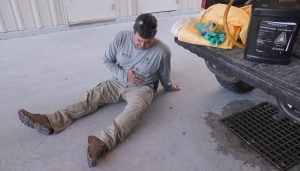 It has been some time since we have discussed the Pesticide Exposure series, time to get back to it. So far in this series we have discussed risk, the types of exposure, which activities cause exposure, and how to possibly reduce risk of the various activities. All of this has discussed “possible” exposure, now we will focus on “actual” exposure. What are the various routes of exposure that an applicator experiences while applying pesticides, and what are some of the symptoms? We will also have a little fun with some 80’s songs along the way.
It has been some time since we have discussed the Pesticide Exposure series, time to get back to it. So far in this series we have discussed risk, the types of exposure, which activities cause exposure, and how to possibly reduce risk of the various activities. All of this has discussed “possible” exposure, now we will focus on “actual” exposure. What are the various routes of exposure that an applicator experiences while applying pesticides, and what are some of the symptoms? We will also have a little fun with some 80’s songs along the way.

Ocular (Eye)
Pesticides “In Your Eyes” can be enough to make you cry. Joking aside it can be a very serious, though less frequent, route of exposure. Eyes are very sensitive and crucial, so any damage can be a problem. Additionally, pesticide in the eyes can cause immediate blurred vision. Imagine trying to find something to wash your eyes out with them closed. Now imagine you are operating a truck, tractor, or walking along a pond and you can’t see. We have previously discussed what to do if you get pesticide in your eyes Help I Got Pesticide In My Eye! And there is this handy publication on the proper PPE to prevent exposure in the first place Protective Eyewear for Pesticide Applicators. Ocular exposure can come from things like spraying into the wind, splashes during pesticide mixing, rubbing pesticide into the eye with dirty hands, or even pesticide sweating into the eyes. Always read the pesticide label for proper PPE and First Aid measures. Many labels will instruct you to rinse for 15 minutes with clean water as quickly as possible. The eyes contain liquid, so the rinse is not merely “washing off” the pesticide, it serves to replace the liquid in the eye and dilute the pesticide out. Always follow the instructions on the label and seek medical attention when necessary.
Inhalation
There are many moments in life that will “Take My Breath Away”, but pesticides in the lungs is one to avoid. This is one of the least common routes of exposure, but one of the most serious. Pesticides that are invisible to the naked eye, like fumigants or very fine droplets are the most at risk for inhalation. What you can’t see can be hard to avoid. Pesticide inhalation can cause shortness of breath, dizziness, nausea, unconsciousness and even death. Follow all label instructions and seek immediate medical attention if inhalation exposure is suspected. Much like flying on an airline, secure your own PPE before helping someone that has inhalation exposure. Remove them to clean air and seek medical help. If you don’t put on proper PPE (things like a respirator) then you too might become unconscious and unable to assist. Always follow all PPE instructions and first aid recommendations on the label.
Ingestion
When I used to work in the field as an applicator it would make me “Hungry Like the Wolf”, but never enough to eat pesticides. Deliberate ingestion of pesticides is very rare, and this route of exposure is one of the easiest to avoid. Keeping ALL pesticides in their original containers is not only the law, but it also avoids confusing a drink with pesticide. Ingestion could happen during mixing and loading if a splash were to get into the mouth and be swallowed, but this is unlikely. The most common way pesticide is ingested is by contaminated food or hands.
Putting your lunch on a dirty tailgate covered in pesticide is not the best of ideas, so always be sure to clean up all spills and keep food away from pesticides. Pesticide labels also recommend ALWAYS washing your hands after handling pesticides and before eating, drinking, using the bathroom. So, avoid eating dirty chips by keeping your hands clean and food away from pesticides. Always check the first aid on a label for instructions on rather to induce vomiting or not in case of exposure.
Dermal (skin)
Finally, we have the most common route of exposure. This one can be easy to miss as pesticide on the skin can almost be like an “Invisible Touch” and easily ignored. You might think, how could you miss pesticide being on your skin, but being covered in sweat while in the field can make this harder than you would think. Dermal exposure may not cause any immediate symptoms, but can also redden the skin, cause rashes or blisters, and in extreme cases cause permanent scarring. Wearing the proper PPE as directed by the label and making sure you are using techniques that limit possible contact are two of the defenses against this exposure. The most powerful defense is one we mentioned related to eyes, washing your hands and skin are a great way to avoid exposure. Soap and water go a long way to limiting possible spread of pesticide exposure. This washing extends to more than just skin, be sure to wash your PPE as well. Clean, functional PPE can dramatically reduce the risk and severity of exposure.
Conclusion
It is finally time to wrap this blog up, this is the “The Final Countdown”. Now its not just the end of this blog, but the end of all the bad 80’s puns and the end of our discussion about pesticide exposure. All pesticides are a hazard and being exposed to them creates risk. The best way to reduce our risk is to reduce our exposure. By understanding how we are exposed, the routes of exposure, symptoms, and preventative measures we can dramatically reduce our risk. I promised no more 80’s references and that we were wrapping up, but I find “It’s So Hard to Say Goodbye”, so if you like this blog and series, share it, like it, and give us feedback. Thank you for allowing me to be so cheesy and hopefully you are learning along the way.
Click To Subscribe
Links
https://blogs.ifas.ufl.edu/pesticideinformation/2021/01/15/pesticide-in-your-eyes/
https://edis.ifas.ufl.edu/publication/PI287
https://blogs.ifas.ufl.edu/pesticideinformation/tag/pesticide-exposure/
 1
1


